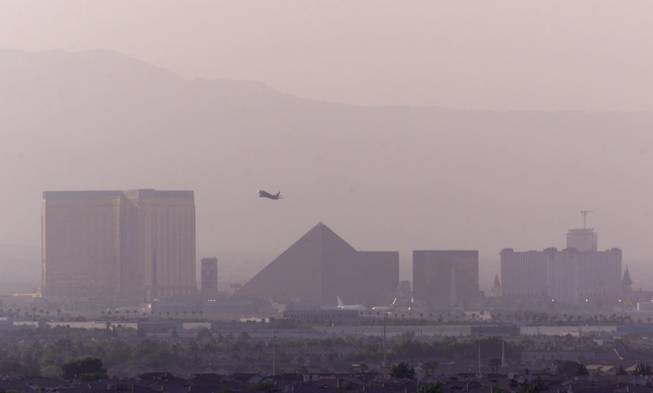
ETHAN MILLER / LAS VEGAS SUN
An airplane takes off from McCarran International Airport as hotel-casinos on the Strip are partially shrouded in haze in this Sun file photo from 2001.
Wednesday, April 19, 2023 | 2:36 p.m.
Ozone levels in the Las Vegas area have improved over the last three years, but other pollution has gotten worse, according to the American Lung Association.
Still, Las Vegas received a failing grade for its pollution levels.
The group’s annual State of the Air report, released today, analyzes how often people in counties and cities nationwide are exposed to two main forms of air pollution: ozone and fine particles from sources like wildfires and car exhaust.
The association, which gives letter grades to each participating jurisdiction, gave Nevada’s Clark and Washoe counties an F in both pollution categories from 2019 to 2021, the years analyzed.
“We attribute that largely due to wildfires and just overall other climate-driven factors like extreme heat, drought and dust storms,” said Melissa Ramos, the Nevada senior manager of clean air advocacy for the American Lung Association.
“All of that is driving up pollution and making it a lot more difficult to clean up,” as well as causing “adverse health effects,” she said.
The report, based on air-quality data from the U.S. Environmental Protection Agency, found Clark County had 47 high-ozone days over the three-year period examined. That was down from 65 days in the previous three-year period.
Any area that has more than 3.3 days of high ozone on a weighted scale receives a failing grade.
Kevin MacDonald, public information administrator for the Clark County Department of Sustainability, said the agency disagrees with the letter grade system.
“We know we have challenges with air quality, especially with ozone, but this is not a fair representation,” MacDonald said.
Air quality in Clark County meets EPA standards most of the time, but wildfires and extreme heat causes spikes in pollution, he said.
This year, April 17 was the first day that exceeded EPA ozone standards, he said.
The county agency has a good relationship with the local chapter of the American Lung Association, “but on this report, we do disagree,” MacDonald said.
The report notes a growing disparity in particle pollution between the eastern and western United States.
In 2004, the year the association started tracking particle pollution, just under half of the counties with failing grades were located west of the Rocky Mountains.
The 2023 report found all but eight of the 111 failing counties were in the West.
Clark County also got an F on particle pollution, with 48 days of unhealthy levels, primarily for sensitive groups. Those groups include people with heart and lung diseases, older adults and children.
Washoe County got an F as well, with 34 days of pollution levels unhealthy for sensitive groups and two days considered unhealthy for the general public.
“Especially in the western U.S., we’ve seen some of the worst wildfires over the past few years,” Ramos said. And the smoke from those fires can drift hundreds of miles, she said.
Nevada can improve air quality, however, by focusing on lowering vehicle emissions, which react with heat and sunlight to create ozone.
To that end, the American Lung Association is supporting Nevada Assembly Bill 184, which would create an incentive program for the purchase of certain zero-emission vehicles.
